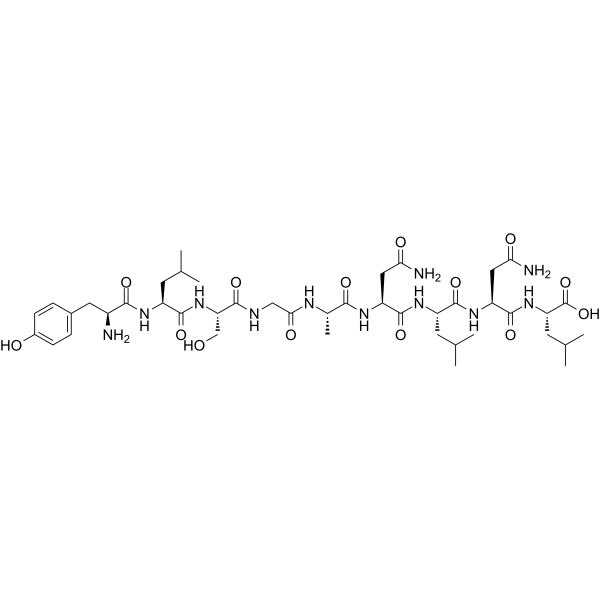Search Result
Results for "
Antigen peptide
" in MedChemExpress (MCE) Product Catalog:
1
Biochemical Assay Reagents
| Cat. No. |
Product Name |
Target |
Research Areas |
Chemical Structure |
-
- HY-157280
-
|
|
Others
|
Inflammation/Immunology
|
|
AdCaPy is an MHC II antigen loading catalyst that accelerates the loading of peptide antigens by MHC II. AdCaPy is a useful molecular tool for enhancing immune responses .
|
-
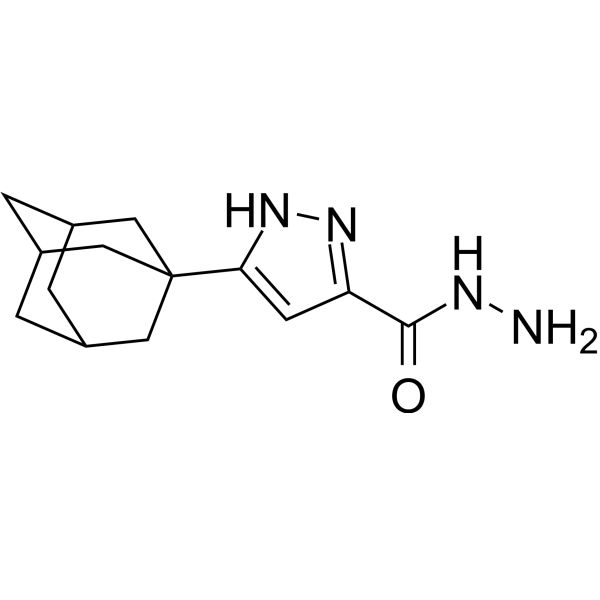
-
- HY-P4156
-
|
|
mAChR
|
Neurological Disease
|
|
VLVNTFCDSCIPKTYWNLGY TFA is an antigenic peptide of M3 muscarinic receptor (M3R). VLVNTFCDSCIPKTYWNLGY TFA can be used in ELISA .
|
-

-
- HY-157171
-
|
|
Others
|
Inflammation/Immunology
|
|
Ac-YR-NH2 is a small molecule modulator of MHC class II antigen presentation. Ac-YR-NH2 can influence peptide binding by MHC II to influence immune response .
|
-
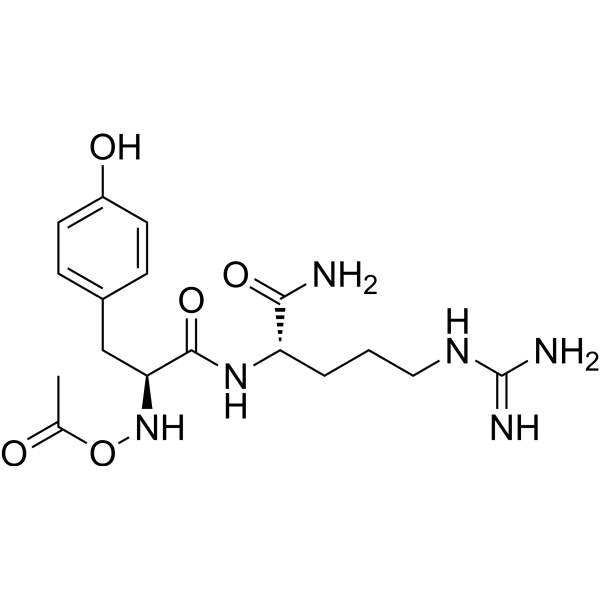
-
- HY-P5930
-
|
MDM2 32-46
|
Ligands for E3 Ligase
|
Cancer
|
|
HOXB7 8–25 (MDM2 32-46) is an MDM2-derived peptide epitope and can elicit antigen-specifc and tumor-reactive CD4 + T cell responses .
|
-
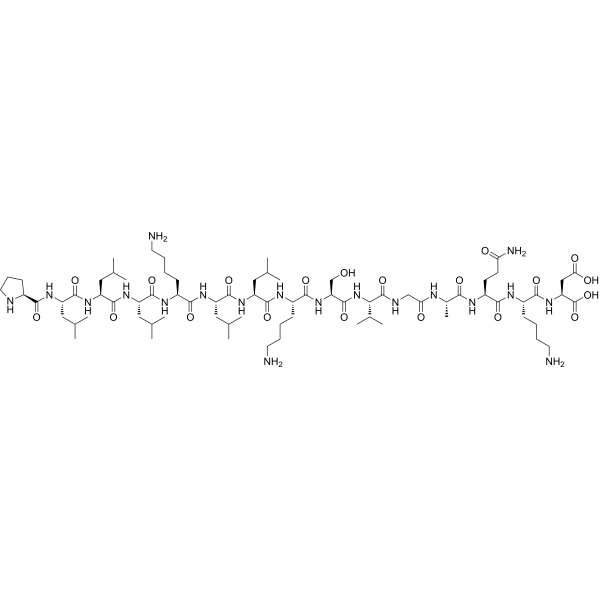
-
- HY-P3590
-
|
|
HCV
|
Others
|
|
PQDVKFP is a synthetic peptide, recognizing antigenic domains within the hepatitis C virus (HCV) core protein .
|
-
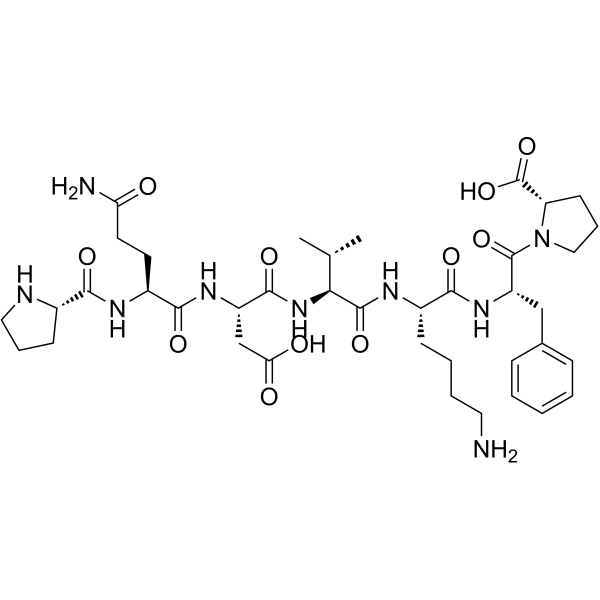
-
- HY-P5623B
-
|
RVG29 TFA; RDP TFA; Rabies Virus Glycoprotein-29 TFA
|
Bacterial
|
Infection
|
|
RVG TFA is a peptide derived from Rabies Virus Glycoprotein that binds to the α-7 subunit of nicotinic acetylcholine receptors (AchR) of neuronal cells. RVG enhances delivery of Mycobacterium tuberculosis antigens to antigen-presenting cells .
|
-

-
- HY-P5623
-
|
RVG29; RDP; Rabies Virus Glycoprotein-29
|
Bacterial
|
Infection
|
|
RVG (RVG29) is a peptide derived from Rabies Virus Glycoprotein that binds to the α-7 subunit of nicotinic acetylcholine receptors (AchR) of neuronal cells. RVG enhances delivery of Mycobacterium tuberculosis antigens to antigen-presenting cells .
|
-

-
- HY-P4050
-
|
|
HBV
|
Infection
|
|
HBV Seq1 aa:18-27 is a hepatitis B virus (HBV) core antigen 18-27 peptide fragment .
|
-
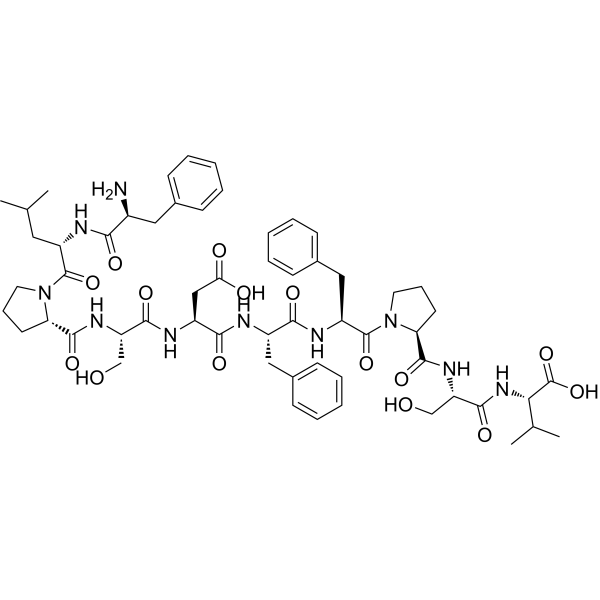
-
- HY-P4048
-
|
|
HBV
|
Infection
|
|
HBV Seq1 aa:93-100 is a hepatitis B virus (HBV) core antigen 93-100 peptide fragment .
|
-
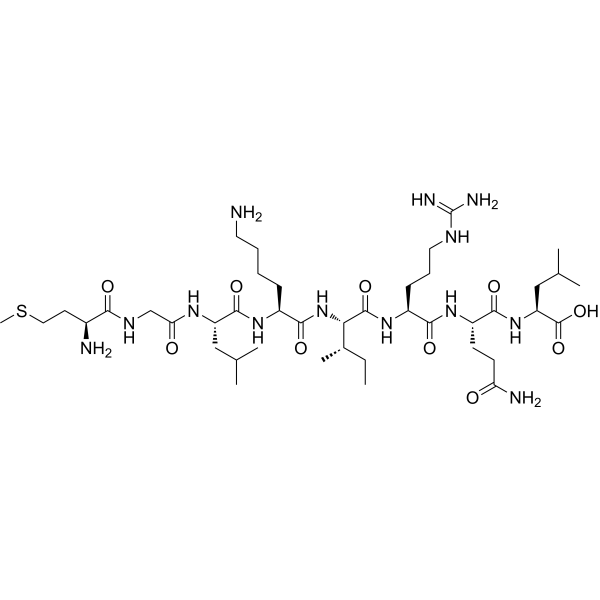
-
- HY-156087
-
|
|
Apoptosis
Necroptosis
|
Cancer
|
|
Cholicamideβ (GMP) is a GMP grade of Cholicamideβ. Cholicamideβ (compound 6) is a self-assembling, small molecule, cancer vaccine adjuvant. Cholicamideβ can form virus-like particles with low cytotoxicity. Cholicamideβ, upon binding to peptide antigens, enhances antigen presentation by dendritic cells and induces antigen-specific T cells. Cholicamideβ can induce apoptosis and necrosis .
|
-
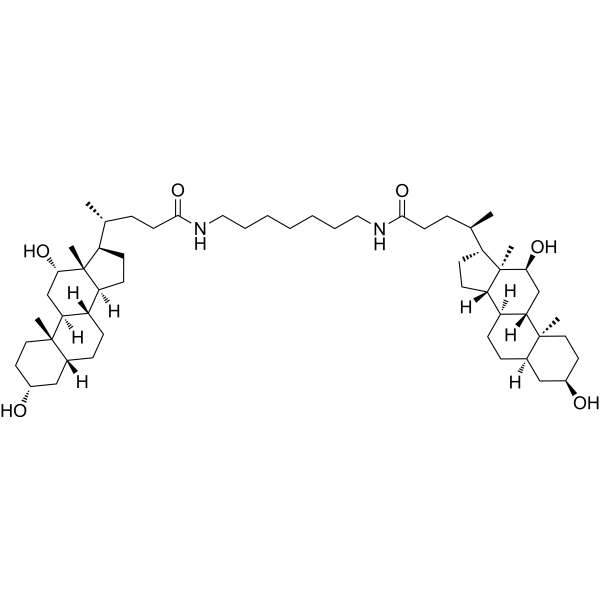
-
- HY-156087G
-
|
|
Apoptosis
Necroptosis
|
Cancer
|
|
Cholicamideβ (GMP) is a GMP grade of Cholicamideβ. Cholicamideβ (compound 6) is a self-assembling, small molecule, cancer vaccine adjuvant. Cholicamideβ can form virus-like particles with low cytotoxicity. Cholicamideβ, upon binding to peptide antigens, enhances antigen presentation by dendritic cells and induces antigen-specific T cells. Cholicamideβ can induce apoptosis and necrosis .
|
-
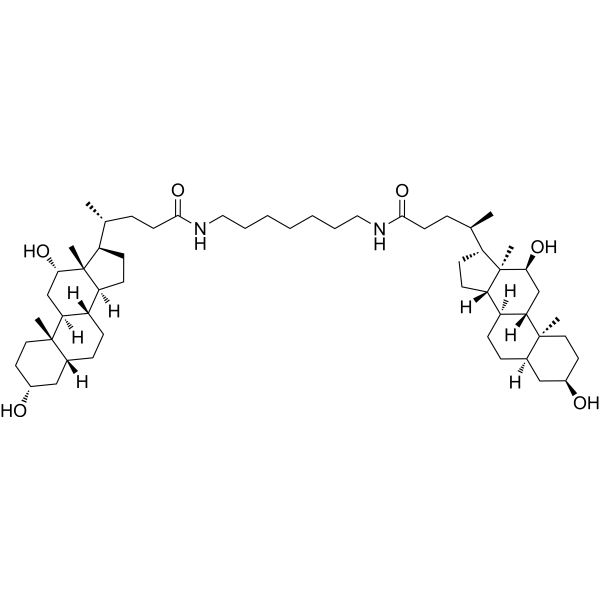
-
- HY-P1566
-
|
|
HIV
|
Infection
|
|
MPG, HIV related is 27-aa peptide, derived from both the nuclear localisation sequence of SV40 large T antigen and the fusion peptide domain of HIV-1 gp41 and is a potent delivery agent for the generalised delivery of nucleic acids and of oligonucleotides into cultured cells.
|
-
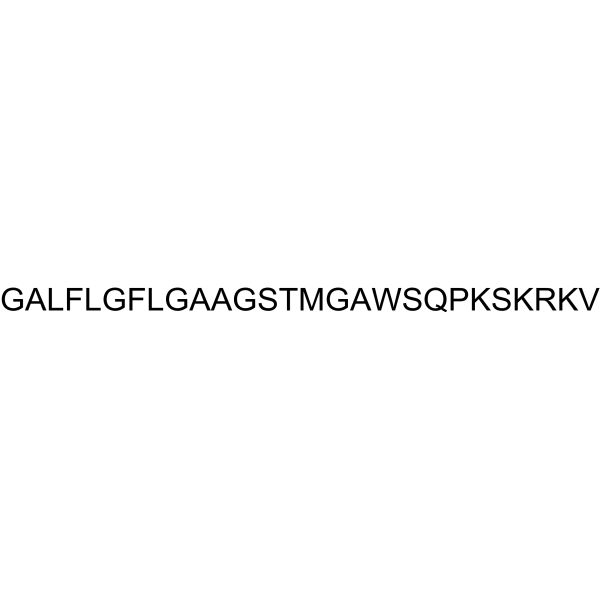
-
- HY-P1778
-
|
|
HPV
|
Infection
|
|
HPV16 E7 (86-93) is a human leukocyte antigen (HLA)-A2.1 restricted HPV16 E7-derived peptide. HPV16 E7 (86-93) is immunogenic in cervical carcinomas .
|
-
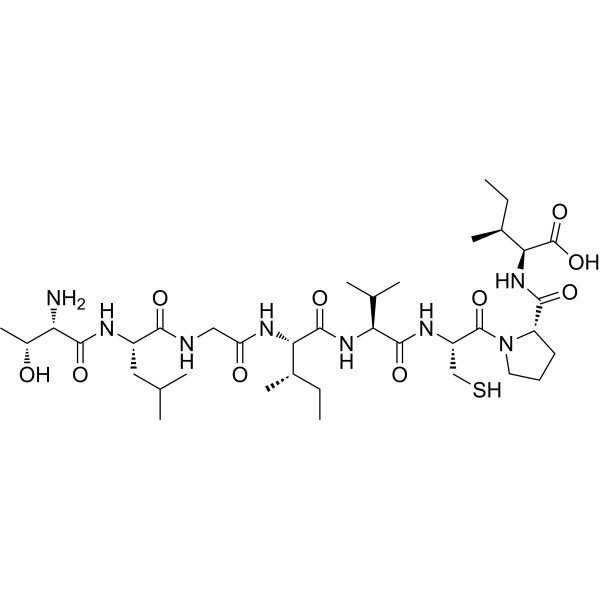
-
- HY-P1778A
-
|
|
HPV
|
Infection
|
|
HPV16 E7 (86-93) TFA is a human leukocyte antigen (HLA)-A2.1 restricted HPV16 E7-derived peptide. HPV16 E7 (86-93) TFA is immunogenic in cervical carcinomas .
|
-
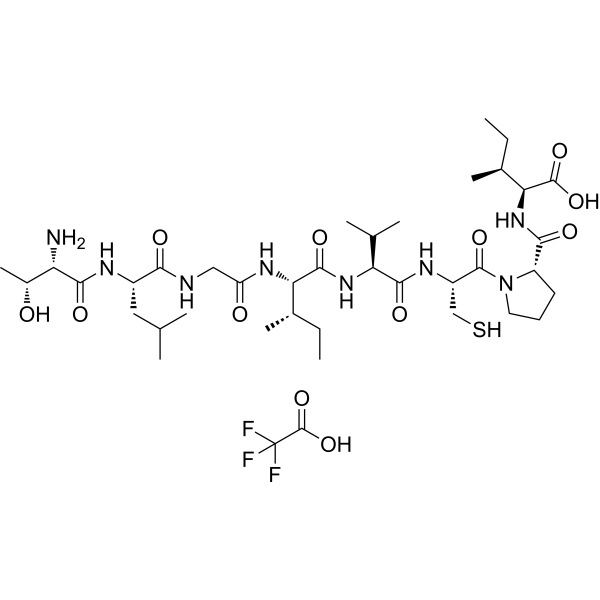
-
- HY-16215
-
|
G-202
|
Drug-Linker Conjugates for ADC
|
Cancer
|
|
Mipsagargin (G-202) is a novel thapsigargin-based targeted proagent consisting of a prostate-specific membrane antigen (PSMA)-specific peptide coupled to an analog of the potent sarcoplasmic/endoplasmic reticulum calcium adenosine triphosphatase (SERCA) pump inhibitor Thapsigargin (HY-13433). Mipsagargin is activated by PSMA-mediated cleavage of an inert masking peptide. Mipsagargin has the potential for refractory, advanced or metastatic solid tumours research .
|
-
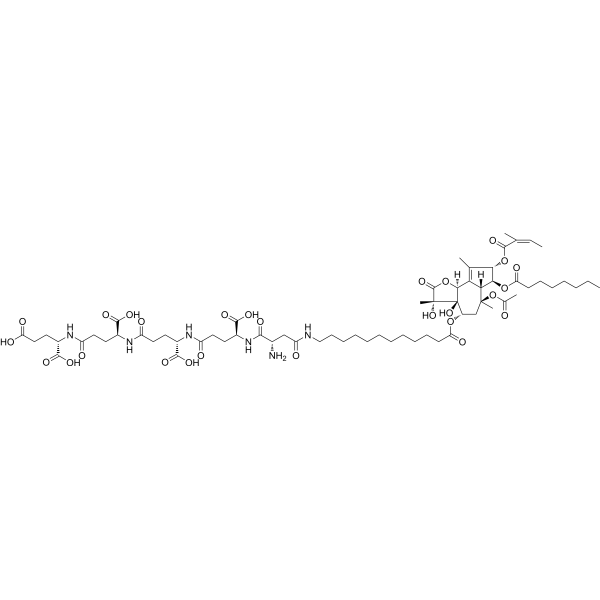
-
- HY-43869
-
|
PSMA-617 Ligand-Linker Conjugate
|
ADC Linker
|
Cancer
|
|
Vipivotide tetraxetan Ligand-Linker Conjugate (PSMA-617 Ligand-Linker Conjugate) is a complex composed of pharmacophore group Glutamate-urea-Lysine peptide coupling linker, which can be used to synthesize Vipivotide tetraxetan (PSMA-617). Glutamate-urea-Lysine selectively binds to prostate-specific membrane antigen (PSMA) .
|
-
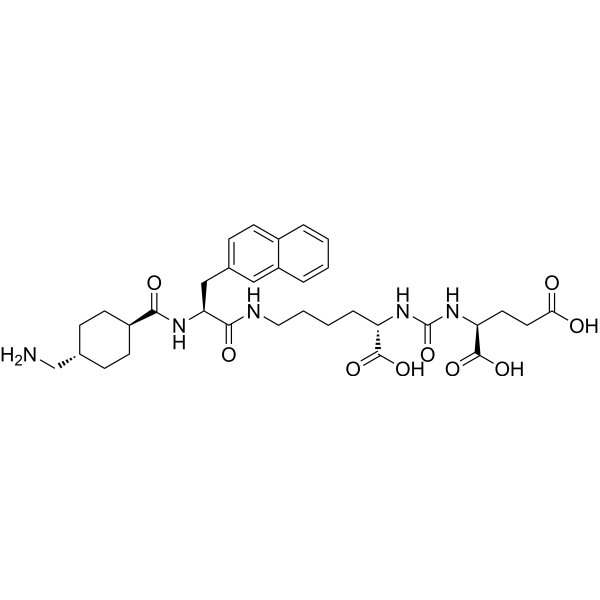
-
- HY-P1920
-
|
|
EBV
|
Inflammation/Immunology
|
|
CEF19, Epstein-Barr Virus latent NA-3A (458-466) is a single peptide epitope, YPLHEQHGM, representing residues 458-466 of the type 1 Epstein-Barr Virus (EBV) nuclear antigen 3A protein (B95.8 strain). CEF19, Epstein-Barr Virus latent NA-3A (458-466) can significantly affect cytotoxic T-lymphocyte (CTL) recognition .
|
-
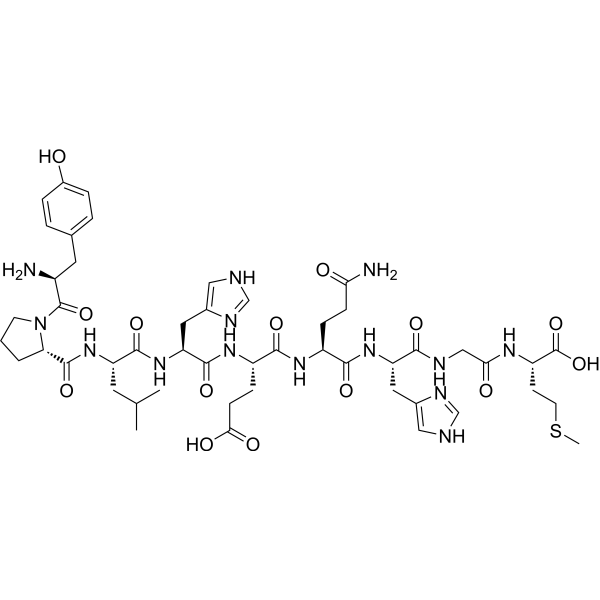
-
- HY-P2358
-
|
|
Toll-like Receptor (TLR)
|
Inflammation/Immunology
|
|
PSMα3 is a peptide for manipulating DCs to become tolerogenic for DC vaccination strategies. PSMα3 penetrates and modulates human monocyte-derived DCs by altering the TLR2- or TLR4-induced maturation, inhibiting pro- and anti-inflammatory cytokine production and reducing antigen uptake. PSMα3 is an important toxin released by the most virulent strains of methicillin-resistant Staphylococcus aureus (MRSA) .
|
-

-
- HY-P3444
-
|
PECAM-1
|
SHP2
Bacterial
|
Metabolic Disease
Inflammation/Immunology
|
|
CD31 (PECAM-1) is platelet endothelial cell adhesion molecule-1, serves as the endothelial cell-specific receptor of clostridium perfringens b-Toxin (CPB). CD31 is also an ER-MP12 antigen, acts as a linker between mechanical stress, metabolism and inflammation. CD31 peptide is able to sustain phosphorylation of the CD31 ITIM686 and of SHP2 and to inhibit TCR-induced T-cell activation - .
|
-

-
- HY-P3444A
-
|
PECAM-1 TFA
|
SHP2
Bacterial
|
Metabolic Disease
Inflammation/Immunology
|
|
CD31 (PECAM-1) TFA is platelet endothelial cell adhesion molecule-1, serves as the endothelial cell-specific receptor of clostridium perfringens b-Toxin (CPB). CD31 TFA is also an ER-MP12 antigen, acts as a linker between mechanical stress, metabolism and inflammation. CD31 TFA peptide is able to sustain phosphorylation of the CD31 ITIM686 and of SHP2 and to inhibit TCR-induced T-cell activation - .
|
-

-
- HY-P99339
-
|
IMCgp100
|
Interleukin Related
TNF Receptor
|
Cancer
|
|
Tebentafusp (IMCgp100) is a bispecific fusion protein to target gp100 peptide-HLA-A*02:01 (a melanoma-associated antigen). Tebentafusp guides T cells to kill gp100-expressing tumor cells via a high affinity T-cell receptor (TCR) binding domain and an anti-CD3 T-cell engaging domain. Tebentafusp leads to inflammatory cytokines and cytolytic proteins production, resulting in the direct lysis of tumour cells .
|
-

-
- HY-155446
-
|
|
Others
|
Inflammation/Immunology
Cancer
|
|
di-DTPA-LTL is a bivalent hapten based on tyrosine-containing polypeptide design. di-DTPA-LTL has good hydrophilia and biological distribution. di-DTPA-LTL is labeled with 111In (indium) and 131I (iodine). di-DTPA-LTL achieves tumor radioimmunoimaging in primary colorectal cancer patients with CEA by injecting a fixed low dose (5 mg) of bispecific antibody (anti-CEA x, anti-DTPA) and di-DTPA antigen peptide (labeled 111In) into the patients .
|
-
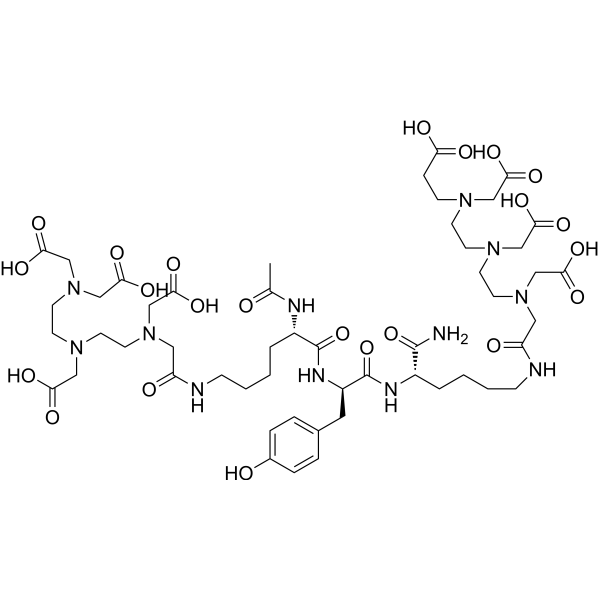
| Cat. No. |
Product Name |
Type |
-
- HY-156087G
-
|
|
Fluorescent Dye
|
|
Cholicamideβ (GMP) is a GMP grade of Cholicamideβ. Cholicamideβ (compound 6) is a self-assembling, small molecule, cancer vaccine adjuvant. Cholicamideβ can form virus-like particles with low cytotoxicity. Cholicamideβ, upon binding to peptide antigens, enhances antigen presentation by dendritic cells and induces antigen-specific T cells. Cholicamideβ can induce apoptosis and necrosis .
|
| Cat. No. |
Product Name |
Type |
-
- HY-156087G
-
|
|
Biochemical Assay Reagents
|
|
Cholicamideβ (GMP) is a GMP grade of Cholicamideβ. Cholicamideβ (compound 6) is a self-assembling, small molecule, cancer vaccine adjuvant. Cholicamideβ can form virus-like particles with low cytotoxicity. Cholicamideβ, upon binding to peptide antigens, enhances antigen presentation by dendritic cells and induces antigen-specific T cells. Cholicamideβ can induce apoptosis and necrosis .
|
| Cat. No. |
Product Name |
Target |
Research Area |
-
- HY-P0277
-
|
CAP1; CEA peptide
|
Peptides
|
Cancer
|
|
Carcinoembryonic antigen peptide 1 (CAP1) is a tumor marker in lung cancer.
|
-
- HY-P4156
-
|
|
mAChR
|
Neurological Disease
|
|
VLVNTFCDSCIPKTYWNLGY TFA is an antigenic peptide of M3 muscarinic receptor (M3R). VLVNTFCDSCIPKTYWNLGY TFA can be used in ELISA .
|
-
- HY-P5972
-
|
|
Peptides
|
Cancer
|
|
GRP20–29, frog is a 10-amino acid antigen peptide that can be isolated from Xenopus .
|
-
- HY-P5930
-
|
MDM2 32-46
|
Ligands for E3 Ligase
|
Cancer
|
|
HOXB7 8–25 (MDM2 32-46) is an MDM2-derived peptide epitope and can elicit antigen-specifc and tumor-reactive CD4 + T cell responses .
|
-
- HY-P4155
-
-
- HY-P2495
-
|
|
Peptides
|
Cancer
|
|
OVA (241-270), a non-specific cytotoxic T lymphocyte (CTL) peptide, is a fragmented peptide of OVA (ovalbumin) antigen .
|
-
- HY-P5304A
-
-
- HY-P2495A
-
|
|
Peptides
|
Inflammation/Immunology
|
|
OVA (241-270) TFA, a non-specific cytotoxic T lymphocyte (CTL) peptide, is a fragmented peptide of OVA (ovalbumin) antigen .
|
-
- HY-P5406
-
|
SAINFEKL, OVA (257-264) Variant
|
Peptides
|
Others
|
|
OVA-A2 Peptide (SAINFEKL, OVA (257-264) Variant) is a biological active peptide. (A2 peptide (SAINFEKL) is a (OVA) peptide (257-264) variant with antigenic effect.)
|
-
- HY-P1813
-
|
PSA-peptide
|
Peptides
|
Cancer
|
|
PSA1 (141-150), a prostate specific antigen 1 peptide, is used in the immunotherapy of cancer experiments .
|
-
- HY-P3590
-
|
|
HCV
|
Others
|
|
PQDVKFP is a synthetic peptide, recognizing antigenic domains within the hepatitis C virus (HCV) core protein .
|
-
- HY-P5623B
-
|
RVG29 TFA; RDP TFA; Rabies Virus Glycoprotein-29 TFA
|
Bacterial
|
Infection
|
|
RVG TFA is a peptide derived from Rabies Virus Glycoprotein that binds to the α-7 subunit of nicotinic acetylcholine receptors (AchR) of neuronal cells. RVG enhances delivery of Mycobacterium tuberculosis antigens to antigen-presenting cells .
|
-
- HY-P5623
-
|
RVG29; RDP; Rabies Virus Glycoprotein-29
|
Bacterial
|
Infection
|
|
RVG (RVG29) is a peptide derived from Rabies Virus Glycoprotein that binds to the α-7 subunit of nicotinic acetylcholine receptors (AchR) of neuronal cells. RVG enhances delivery of Mycobacterium tuberculosis antigens to antigen-presenting cells .
|
-
- HY-P1700
-
|
|
Peptides
|
Cancer
|
|
BCMA72-80 is a HLA-A2-specific B-cell maturation antigen (BCMA) peptide, with great affinity to HLA-A2, used in the research of multiple myeloma or other B-cell maturation antigen expressing tumors .
|
-
- HY-P4050
-
|
|
HBV
|
Infection
|
|
HBV Seq1 aa:18-27 is a hepatitis B virus (HBV) core antigen 18-27 peptide fragment .
|
-
- HY-P4048
-
|
|
HBV
|
Infection
|
|
HBV Seq1 aa:93-100 is a hepatitis B virus (HBV) core antigen 93-100 peptide fragment .
|
-
- HY-P2511
-
|
|
Peptides
|
Metabolic Disease
|
|
Insulin β Chain Peptide (15-23) is one of the earliest antigenic epitopes to which CD8 T-cells respond .
|
-
- HY-P2494
-
-
- HY-P10264
-
|
MAGE-3(168-176), human
|
Peptides
|
Cancer
|
|
MAGE-3 peptide (MAGE-3 168-176, human) is a peptide encoded by human MAGE-3 gene, which is expressed in tumor cells, presented by HLA and recognized by cytolytic T lymphocytes (CTL) as tumor antigen .
|
-
- HY-P1566
-
|
|
HIV
|
Infection
|
|
MPG, HIV related is 27-aa peptide, derived from both the nuclear localisation sequence of SV40 large T antigen and the fusion peptide domain of HIV-1 gp41 and is a potent delivery agent for the generalised delivery of nucleic acids and of oligonucleotides into cultured cells.
|
-
- HY-P5488
-
|
|
Peptides
|
Others
|
|
BDC2.5 Mimotope 1040-63 is a biological active peptide. (The TCR transgenic model (BDC2.5) mimitope was used in type 1 diabetes (T1D) study. T1D is an autoimmune disease in which T cells mediate damage to pancreatic islet b cells. T1D is caused by autoreactive T cell destruction of insulin-producing cells. BDC2.5 mimotope was utilized to support the study on antigen presentation of antigenic peptides to islet autoantigen-specific T cells.)
|
-
- HY-P1826
-
|
|
Peptides
|
Inflammation/Immunology
Cancer
|
|
CLIP (86-100) is amino acids 86 to 100 fragment of class II-associated invariant chain peptide (CLIP). CLIP is a small self-peptide and cleavage product of the invariant chain that resides in the HLA-II antigen binding groove and is believed to play a critical role in the assembly and transport of MHC class II alphabetaIi complexes through its interaction with the class II peptide-binding site .
|
-
- HY-P1917
-
|
|
Peptides
|
Inflammation/Immunology
|
|
Uty HY Peptide (246-254), derived from the ubiquitously transcribed tetratricopeptide repeat gene on the Y chromosome (UTY) protein as an H-Y epitope, H-YD b, is a male-specific transplantation antigen H-Y .
|
-
- HY-P1917A
-
|
|
Peptides
|
Inflammation/Immunology
|
|
Uty HY Peptide (246-254) TFA, derived from the ubiquitously transcribed tetratricopeptide repeat gene on the Y chromosome (UTY) protein as an H-Y epitope, H-YD b, is a male-specific transplantation antigen H-Y .
|
-
- HY-P1826A
-
|
|
Peptides
|
Inflammation/Immunology
Cancer
|
|
CLIP (86-100) TFA is amino acids 86 to 100 fragment of class II-associated invariant chain peptide (CLIP). CLIP is a small self-peptide and cleavage product of the invariant chain that resides in the HLA-II antigen binding groove and is believed to play a critical role in the assembly and transport of MHC class II alphabetaIi complexes through its interaction with the class II peptide-binding site .
|
-
- HY-P5479
-
|
|
Peptides
|
Others
|
|
EE epitope is a biological active peptide. (This peptide is a 314 to 319 amino acids fragment of the middle T antigen of mouse polymavirus. Glu-Glu epitope peptide is widely used as an epitope tag.Pyroglutamyl (pGlu) peptides may spontaneously form when either Glutamine (Q) or Glutamic acid (E) is located at the sequence N-terminus. The conversion of Q or E to pGlu is a natural occurrence and in general it is believed that the hydrophobic γ-lactam ring of pGlu may play a role in peptide stability against gastrointestinal proteases. Pyroglutamyl peptides are therefore considered a normal subset of such peptides and are included as part of the peptide purity during HPLC analysis.)
|
-
- HY-P2524
-
|
|
Peptides
|
Cancer
|
|
MAGE-3 (271-279) is a 271-279 residue peptide derived from melanoma antigens encoded by MAGE-3. MAGE-3 is a cytolytic T lymphocyte (CTL)-defined MAGE-3 protein associated with the human leukocyte antigen (HLA)-A2 molecule. MAGE-3 is overexpressed in different human tumor types, including malignant melanoma, but not by normal tissues except for testis and placenta .
|
-
- HY-12523
-
|
|
Peptides
|
Others
|
|
Peptide M is a synthetic amino acid (18 amino acids in length which correspond to the amino acid positions 303-322 of bovine S-antigen: DTNLASSTIIKEGIDKTV), is capable of inducing experimental autoimmune uveitis in monkeys and Hartley guinea pigs as well as Lewis rats .
|
-
- HY-P1778
-
|
|
HPV
|
Infection
|
|
HPV16 E7 (86-93) is a human leukocyte antigen (HLA)-A2.1 restricted HPV16 E7-derived peptide. HPV16 E7 (86-93) is immunogenic in cervical carcinomas .
|
-
- HY-P5448
-
|
|
Peptides
|
Others
|
|
MOG (92–106), mouse, rat is a biological active peptide. (This is amino acids 92 to 106 fragment of the myelin oligodendrocyte glycoprotein (MOG) from mouse/rat. Mice with MOG (92–106)-induced experimental autoimmune encephalomyelitis develop extensive B cell reactivity against secondary myelin antigens. Despite the fact that this MOG peptide induces only weak T cell responses, MOG-induced autoimmunity is very severe. This peptide is encephalitogenic in SJL mice, DA rats, and rhesus monkeys.)
|
-
- HY-P1778A
-
|
|
HPV
|
Infection
|
|
HPV16 E7 (86-93) TFA is a human leukocyte antigen (HLA)-A2.1 restricted HPV16 E7-derived peptide. HPV16 E7 (86-93) TFA is immunogenic in cervical carcinomas .
|
-
- HY-16215
-
|
G-202
|
Drug-Linker Conjugates for ADC
|
Cancer
|
|
Mipsagargin (G-202) is a novel thapsigargin-based targeted proagent consisting of a prostate-specific membrane antigen (PSMA)-specific peptide coupled to an analog of the potent sarcoplasmic/endoplasmic reticulum calcium adenosine triphosphatase (SERCA) pump inhibitor Thapsigargin (HY-13433). Mipsagargin is activated by PSMA-mediated cleavage of an inert masking peptide. Mipsagargin has the potential for refractory, advanced or metastatic solid tumours research .
|
-
- HY-P5912
-
|
|
Peptides
|
Neurological Disease
|
|
GluN1 (356-385) is an antigenic peptide against
N-methyl-D-aspartate receptor (NMDAR) encephalitis. GluN1 (356-385) has the
effect of reducing the density of surface NMDAR clusters in hippocampal
neurons. GluN1 (356-385) can be used to study the pathogenesis of anti-NMDAR
encephalitis .
|
-
- HY-P5471
-
|
[Leu27]-Melan-A, MART-1 (26-35)
|
Peptides
|
Others
|
|
Melan-A/MART-1 analog ([Leu27]-Melan-A, MART-1 (26-35)) is a biological active peptide. (This Melan-A (26-35) analog, Leu substituted for Ala at position 27, shows better HLA-A*0201 binding properties as well as better immunogenicity and antigenicity than the natural Melan-A (26-35).Pyroglutamyl (pGlu) peptides may spontaneously form when either Glutamine (Q) or Glutamic acid (E) is located at the sequence N-terminus. The conversion of Q or E to pGlu is a natural occurrence and in general it is believed that the hydrophobic γ-lactam ring of pGlu may play a role in peptide stability against gastrointestinal proteases. Pyroglutamyl peptides are therefore considered a normal subset of such peptides and are included as part of the peptide purity during HPLC analysis.)
|
-
- HY-P2525
-
|
|
Peptides
|
Inflammation/Immunology
|
|
GAD65 (206-220) is glutamic acid decarboxylase (GAD) 65-derived peptide, corresponding to residues 180-188. GAD65 is presented to T cells in association with I-Ag7 MHC class II molecules and a major pancreatic antigens targeted by self-reactive T cells in type I diabetes mellitus .
|
-
- HY-P3827
-
|
|
Peptides
|
Inflammation/Immunology
|
|
Cys-Gly-Tyr-Gly-Pro-Lys-Lys-Lys-Arg-Lys-Val-Gly-Gly is a13-mer synthetic peptide containing seven amino acids homologous to SV40 T antigen. Cys-Gly-Tyr-Gly-Pro-Lys-Lys-Lys-Arg-Lys-Val-Gly-Gly is capable of inducing nuclear transport .
|
-
- HY-P5396
-
|
|
Peptides
|
Others
|
|
GAD65 (524-543) is a biological active peptide. (This is amino acids 524 to 543 fragment of glutamic acid decarboxylase 65 (GAD65). It is one of the first fragments of this islet antigen to induce proliferative T cell responses in the non-obese diabetic (NOD) mouse model of spontaneous autoimmune diabetes. This peptide is a specific, possibly low affinity, stimulus for the spontaneously arising diabetogenic T cell clone BDC2.5. Immunization with p524–543 increases the susceptibility of the NOD mice to type 1 diabetes induced by the adoptive transfer of BDC2.5 T cells.)
|
-
- HY-P1920
-
|
|
EBV
|
Inflammation/Immunology
|
|
CEF19, Epstein-Barr Virus latent NA-3A (458-466) is a single peptide epitope, YPLHEQHGM, representing residues 458-466 of the type 1 Epstein-Barr Virus (EBV) nuclear antigen 3A protein (B95.8 strain). CEF19, Epstein-Barr Virus latent NA-3A (458-466) can significantly affect cytotoxic T-lymphocyte (CTL) recognition .
|
-
- HY-P2358
-
|
|
Toll-like Receptor (TLR)
|
Inflammation/Immunology
|
|
PSMα3 is a peptide for manipulating DCs to become tolerogenic for DC vaccination strategies. PSMα3 penetrates and modulates human monocyte-derived DCs by altering the TLR2- or TLR4-induced maturation, inhibiting pro- and anti-inflammatory cytokine production and reducing antigen uptake. PSMα3 is an important toxin released by the most virulent strains of methicillin-resistant Staphylococcus aureus (MRSA) .
|
-
- HY-P3444
-
|
PECAM-1
|
SHP2
Bacterial
|
Metabolic Disease
Inflammation/Immunology
|
|
CD31 (PECAM-1) is platelet endothelial cell adhesion molecule-1, serves as the endothelial cell-specific receptor of clostridium perfringens b-Toxin (CPB). CD31 is also an ER-MP12 antigen, acts as a linker between mechanical stress, metabolism and inflammation. CD31 peptide is able to sustain phosphorylation of the CD31 ITIM686 and of SHP2 and to inhibit TCR-induced T-cell activation - .
|
-
- HY-P2358A
-
|
|
Peptides
|
Inflammation/Immunology
|
|
PSMα3 TFA is a peptide for manipulating DCs to become tolerogenic for DC vaccination strategies. PSMα3 TFA penetrates and modulates human monocyte-derived DCs by altering the TLR2- or TLR4-induced maturation, inhibiting pro- and anti-inflammatory cytokine production and reducing antigen uptake. PSMα3 TFA is an important toxin released by the most virulent strains of methicillin-resistant Staphylococcus aureus (MRSA) .
|
-
- HY-P3444A
-
|
PECAM-1 TFA
|
SHP2
Bacterial
|
Metabolic Disease
Inflammation/Immunology
|
|
CD31 (PECAM-1) TFA is platelet endothelial cell adhesion molecule-1, serves as the endothelial cell-specific receptor of clostridium perfringens b-Toxin (CPB). CD31 TFA is also an ER-MP12 antigen, acts as a linker between mechanical stress, metabolism and inflammation. CD31 TFA peptide is able to sustain phosphorylation of the CD31 ITIM686 and of SHP2 and to inhibit TCR-induced T-cell activation - .
|
-
- HY-P10021
-
| Cat. No. |
Product Name |
Target |
Research Area |
-
- HY-P99339
-
|
IMCgp100
|
Interleukin Related
TNF Receptor
|
Cancer
|
|
Tebentafusp (IMCgp100) is a bispecific fusion protein to target gp100 peptide-HLA-A*02:01 (a melanoma-associated antigen). Tebentafusp guides T cells to kill gp100-expressing tumor cells via a high affinity T-cell receptor (TCR) binding domain and an anti-CD3 T-cell engaging domain. Tebentafusp leads to inflammatory cytokines and cytolytic proteins production, resulting in the direct lysis of tumour cells .
|
| Cat. No. |
Product Name |
Category |
Target |
Chemical Structure |
| Cat. No. |
Compare |
Product Name |
Species |
Source |
Compare Products
|
| Products |
|
| Cat. No. |
|
| Species |
|
| Source |
|
| Tag |
|
| Accession |
|
| Gene ID |
|
| Molecular Weight |
|
| Purity |
|
| Endotoxin Level |
|
| Biological Activity |
|
| Appearance |
|
| Formulation |
|
| Storage & Stability |
|
| Shipping |
|
| Free Sample |
Yes
No
|
| Size |
* This product has been "discontinued".
Optimized version of product available:
|
| Cat. No. |
Product Name |
Application |
Reactivity |
-
- HY-P81143
-
|
CCR7_HUMAN; BLR 2; BLR2; C C chemokine receptor type 7; C C CKR 7; CC chemokine receptor 7; CC chemokine receptor type 7; CC CKR 7; CCCKR7; CCR 7; CD 197; CD197; CD197 Antigen; CDW197; Chemokine C C motif receptor 7; Chemokine C C receptor 7; Chemokine receptor 7-like protein; EBI 1; EBI1; Ebi1h; EBV Induced G Protein Coupled Receptor 1; Epstein Barr virus induced G protein coupled receptor; Epstein Barr virus induced gene 1; EVI 1; EVI1; Lymphocyte Specific G Protein Coupled peptide Receptor; MGC108519; MIP 3 beta receptor; MIP3 Beta Receptor.
|
WB; ELISA; IHC-P; IHC-F; Flow-Cyt; ICC; IF
|
Human, Mouse, Rat(predicted: Dog) |
|
CCR7 Antibody is an unconjugated, approximately 42 kDa, rabbit-derived, anti-CCR7 polyclonal antibody. CCR7 Antibody can be used for: WB, ELISA, IHC-P, IHC-F, Flow-Cyt, ICC, IF expriments in human, mouse, rat, and predicted: dog background without labeling.
|
Your information is safe with us. * Required Fields.
Inquiry Information
- Product Name:
- Cat. No.:
- Quantity:
- MCE Japan Authorized Agent:




























